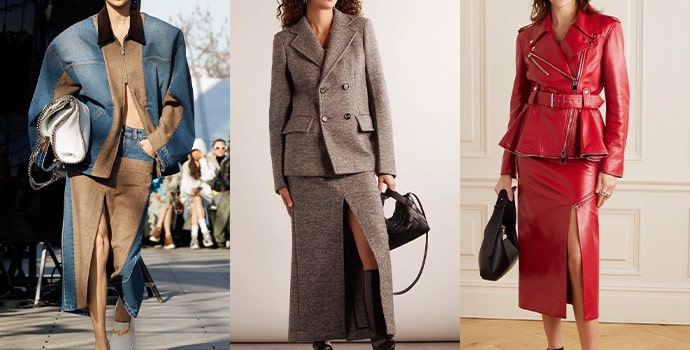Branded Clothing and the Role of Fabric in Defining Your Silhouette
Wiki Article
Comprehending Clothes: The Relevance of Fabric Selections in Your Closet
The selection of textile in clothes plays a critical duty in both appearances and performance. Various products offer differing degrees of breathability, durability, and comfort, straight influencing the wearer's experience. Understanding these nuances can boost one's wardrobe markedly. Lots of ignore how these selections can impact not just individual design, but likewise sustainability. What material decisions could redefine your closet and straighten it with both style and obligation?The Role of Textile in Style and Performance

Typical Material Types and Their Features
When picking apparel, comprehending the features of common material kinds is essential for making educated selections. Cotton, a widely-used natural fiber, is understood for its convenience, breathability, and gentleness, making it ideal for sportswear and everyday garments. Linen, one more natural alternative, boasts superb moisture-wicking homes and an unique structure, suitable for cozy climates.Wool, often preferred for its heat and sturdiness, varies in fineness; merino wool is soft against the skin, while coarser types are utilized for outerwear. Artificial textiles like polyester and nylon provide toughness and resistance to creases, making them popular for activewear and travel garments. Blends, which incorporate synthetic and all-natural fibers, can improve functionality while keeping comfort. By acknowledging these fabric characteristics, individuals can select garments that lines up with their way of living and visual choices.Breathability and Convenience: Selecting the Right Fabrics for Various Environments
Choosing the best fabrics for different environments can considerably enhance comfort and total wearability. Breathable products are important in warm climates, as they allow air flow and wetness evaporation. Fabrics such as cotton, bed linen, and moisture-wicking synthetics efficiently attract sweat far from the body, keeping the wearer cool and dry. On the other hand, in chillier environments, thicker materials like wool or fleece offer insulation while retaining breathability, making certain warmth without overheating.Additionally, the option of fabric weight plays a vital duty; light-weight materials are more effective for summertime, whereas larger alternatives are fit for winter season wear. Recognizing the special properties of each material allows individuals to dress appropriately for varying weather. Eventually, choosing breathable and comfortable materials tailored to specific environments can substantially enhance everyday convenience and boost the general experience of using clothes.Resilience and Care: How Fabric Impacts Durability of Your Closet
Choosing the ideal materials can substantially affect the toughness and care demands of a closet. Fabrics such as cotton and polyester are understood for their strength and ease of upkeep, making them excellent for daily wear. On the other hand, fragile products like silk and lace require more careful handling and specialized cleansing approaches, which can increase the moment and initiative required for care. Branded Clothing.Durability is likewise influenced by the material's weave and surface; tightly woven fabrics tend to stand up to damage far better than freely woven options. Additionally, artificial blends frequently provide boosted sturdiness, integrating the very best top qualities of several fibers.Understanding the care directions for each fabric is essential, as incorrect washing or drying can result in premature wear. Eventually, selecting durable materials can lead to a longer-lasting closet, lowering the regularity of replacements and adding to a more sustainable style selectionThe Effect of Material on Fit and Shape

Sustainable Material Options: Making Eco-Friendly Decisions
The impact of fabric prolongs past fit and shape to encompass ecological aspects, prompting a growing passion in lasting textile choices. Green materials, such as organic cotton, hemp, and Tencel, are getting grip amongst consumers who prioritize sustainability in their wardrobes. These materials are frequently created with fewer chemicals and water, decreasing their environmental footprint.Additionally, recycled fabrics, made from post-consumer waste, use an innovative remedy to the textile industry's air pollution trouble. Brands significantly accept openness in their sourcing techniques, permitting consumers to make educated decisions regarding their purchases.Choosing sustainable materials not just sustains honest methods however additionally motivates the fashion business to adopt even more accountable production methods. As awareness of environmental concerns rises, individuals are prompted to review the lasting effect of their textile choices, fostering an activity towards an extra sustainable and eco aware method to style.
Boosting Style: Just How Textile Can Transform an Outfit
While many might concentrate on color and cut when choosing an outfit, the choice of fabric plays a necessary function in elevating style and boosting general appearance. Different materials share distinct state of minds and messages; as an example, silk exhibits deluxe and sophistication, while jeans supplies a laid-back, relaxed vibe. The structure and drape of a textile can significantly alter the silhouette, with structured fabrics providing a sleek appearance and softer ones creating a more fluid, loosened up aesthetic.Moreover, the weight of the fabric influences wearability throughout periods. Lightweight materials like bed linen and cotton are optimal for summer, while much heavier materials such as wool and velvet supply warmth and sophistication in colder months. Recognizing material residential or commercial properties, such as breathability and stretch, also empowers individuals to make educated options that improve browse this site comfort without jeopardizing style. Inevitably, the best material can change an outfit from average to remarkable, making it an important consideration in any wardrobe.Regularly Asked Concerns
Just how Do I Determine the Material Web Content of My Garments?
To determine material web content, one can examine treatment tags, conduct burn tests for fiber identification, or consult fabric examples. These methods assist distinguish materials, making certain informed choices for clothes treatment and upkeep in daily wear.Can Fabric Option Affect My Mood or Confidence?
Material selection can greatly impact an individual's mood and self-confidence. Branded Clothing. Particular materials may stimulate sensations of convenience or beauty, while others can really feel uncomplimentary or restrictive, ultimately influencing self-perception and emotional health throughout the dayWhat Fabrics Are Best for Sensitive Skin?
For try this out people with sensitive skin, all-natural fabrics like cotton, bed linen, and bamboo are often advised. These products are breathable, hypoallergenic, and much less most likely to cause irritation, making them ideal selections for convenience and skin health.How Do I Appropriately Clean and Care for Different Fabrics?
To properly care and wash for various materials, one need to think about each product's certain needs, consisting of temperature level setups, detergents, and drying techniques, making sure longevity and preserving the textile's initial high qualities for excellent use.Are There Certain Fabrics for Athletic or Performance Put On?
Sports or performance wear often uses fabrics such as polyester, nylon, and spandex. These materials are created for moisture-wicking, breathability, and flexibility, improving motion and convenience throughout physical tasks while supplying durability and support. On the other hand, in cooler climates, thicker materials like wool or fleece provide insulation while maintaining breathability, ensuring warmth without overheating.Additionally, the choice of fabric weight plays an important role; light-weight fabrics are more effective for summer, whereas heavier options are suited for wintertime wear. In comparison, fragile products like silk and lace call for more careful handling and specialized cleansing techniques, which can raise the time and effort needed for care.Durability is likewise affected by the material's weave and coating; snugly woven materials tend to resist wear and tear better than freely woven choices. In comparison, stiff textiles can restrict movement but offer a timeless, polished look.Moreover, the thickness and structure of go to this web-site the textile can affect the visual perception of body shape. The influence of fabric expands past fit and silhouette to encompass ecological elements, prompting an expanding passion in sustainable textile options. The appearance and drape of a textile can considerably modify the silhouette, with structured textiles offering a polished appearance and softer ones creating a much more fluid, unwinded aesthetic.Moreover, the weight of the fabric influences wearability across seasons.Report this wiki page